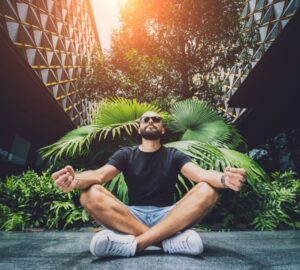Shavasana, also known as Corpse Pose, is a deeply relaxing yoga posture that promotes physical and mental rejuvenation. It is often practiced at the end of a yoga session or as a standalone relaxation technique. In this article, we will explore the steps to practice Shavasana, its numerous benefits, and the precautions one should keep in mind while practicing it.
Steps to Practice Shavasana
To experience the full benefits of Shavasana, it is important to follow the proper steps. Here is a step-by-step guide to practicing Shavasana:
Step 1: Find a Comfortable Position
Find a quiet and peaceful space where you can lie down comfortably on your back. Use a yoga mat or a soft surface like a carpet or blanket to support your body.
Read More: Importance of Yoga Mat
Step 2: Close Your Eyes
Once you are lying down, gently close your eyes. Closing your eyes helps in directing your focus inward and enhances relaxation.
Step 3: Relax Your Body
Start by consciously relaxing each part of your body, starting from your toes and gradually moving up to your head. Release any tension or tightness you may be holding, allowing your body to sink into the ground.
Step 4: Focus on Your Breath
Bring your attention to your breath. Observe the natural rhythm of your breath without trying to control it. Feel the gentle rise and fall of your abdomen with each breath.
Step 5: Clear Your Mind
As thoughts arise in your mind, acknowledge them without judgment and let them pass by. Shift your focus back to your breath, using it as an anchor to keep your mind centered.
Step 6: Stay in the Pose
Remain in Shavasana for 10 to 20 minutes, or as long as you feel comfortable. Allow yourself to fully surrender to the stillness and relaxation of the pose.
Benefits of Shavasana
Shavasana offers a multitude of benefits for both the body and mind. Let’s explore some of the key benefits:
Physical Relaxation
Shavasana promotes deep physical relaxation by releasing tension from the muscles and calming the nervous system. It helps in reducing physical fatigue and restoring energy levels.
Stress Reduction
By inducing a state of deep relaxation, Shavasana effectively reduces stress and anxiety. It activates the body’s relaxation response, lowers blood pressure, and decreases the production of stress hormones.
Read More: Kundalini Yoga Kriya for Stress and Anxiety
Improved Sleep
Regular practice of Shavasana can improve the quality of sleep. It helps in calming the mind, easing restlessness, and preparing the body for a peaceful night’s sleep.
Mental Clarity
Shavasana enhances mental clarity and focus. By allowing the mind to quiet down and let go of thoughts, it creates space for improved concentration, memory, and cognitive function.
Deepened Self-Awareness
During Shavasana, you develop a heightened sense of self-awareness. It offers an opportunity to connect with your inner self, fostering introspection and self-reflection.
Precautions to Consider
While Shavasana is generally safe for most people, there are a few precautions to keep in mind:
Pregnancy
If you are pregnant, it is advisable to modify the pose by elevating your upper body with a bolster or pillow. Avoid lying flat on your back for an extended period to ensure the comfort and safety of both you and your baby.
Recent Injuries or Surgeries
If you have had any recent injuries or surgeries, consult with your healthcare provider or a qualified yoga instructor before practicing Shavasana. They can guide you on modifications or alternatives to ensure your recovery is not compromised.
Chronic Health Conditions
If you have any chronic health conditions, such as high blood pressure, heart disease, or back problems, it is important to seek guidance from a healthcare professional or a yoga therapist. They can provide personalized recommendations based on your specific condition.
Shavasana, the tranquil Corpse Pose, offers a serene space for relaxation and rejuvenation. By following the simple steps and practicing it regularly, you can experience the numerous benefits it has to offer. Remember to listen to your body, honor any precautions, and enjoy the profound stillness that Shavasana brings to your mind, body, and spirit.
Read More: Bhastrika Pranayama Benefits for Skin
FAQs
- Can I practice Shavasana if I have trouble falling asleep? Yes, Shavasana can be beneficial for individuals with sleep difficulties. It helps calm the mind and relax the body, creating a conducive environment for better sleep.
- How long should I stay in Shavasana? Ideally, you should aim to stay in Shavasana for 10 to 20 minutes. However, you can adjust the duration based on your comfort and the time available to you.
- Is Shavasana suitable for beginners? Yes, Shavasana is suitable for beginners. It is a simple pose that requires no prior experience or flexibility. It serves as a valuable tool for relaxation and self-care.
- Can Shavasana help reduce anxiety? Absolutely. Shavasana is known to be effective in reducing anxiety levels. It activates the relaxation response in the body, promoting a sense of calm and tranquility.
-
Can I practice Shavasana after a meal? It is generally recommended to practice Shavasana on an empty stomach for better comfort and digestion. Wait for at least 2 to 3 hours after a meal before engaging in this pose.



